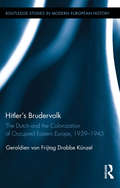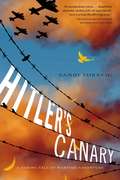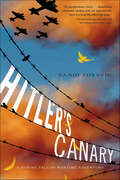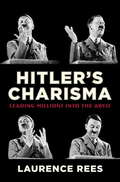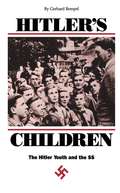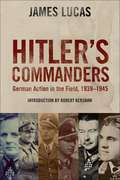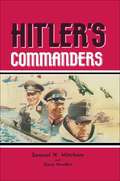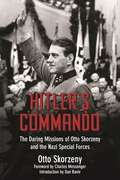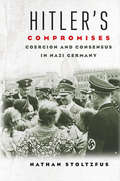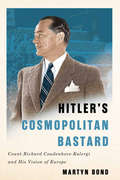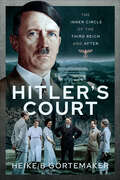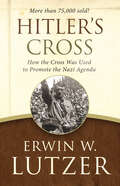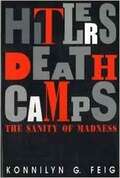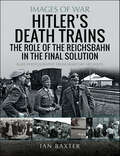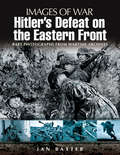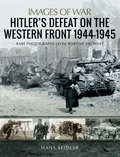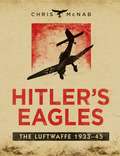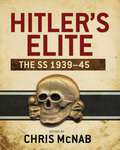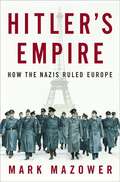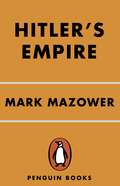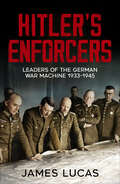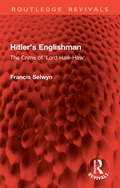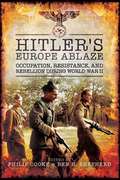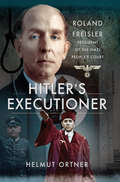- Table View
- List View
Hitler's Brudervolk: The Dutch and the Colonization of Occupied Eastern Europe, 1939-1945 (Routledge Studies in Modern European History)
by Geraldien von Frijtag Drabbe KünzelThis is the first academic book on Dutch colonial aspirations and initiatives during WWII. Between the summers of 1941 and 1944, some 5,500 Dutch men and women left their occupied homeland to find employment in the so-called German Occupied Eastern Territories: Belarus, the Baltic countries and parts of Ukraine. This was the area designated for colonization by Germanic people. It was also the stage of the "Holocaust by Bullets," a centrally coordinated policy of exploitation and oppression and a ruthless anti-partisan war. This book seeks to answer why the Dutch decided to go there, how their recruitment, transfer and stay were organized, and how they reacted to this scene of genocidal violence. It is a close-up study of racial monomania, of empire-building on the old continent and of collaboration in Nazi-occupied Europe.
Hitler's Canary (A Deborah Brodie book)
by Sandi ToksvigBamse's family are theater people. They don't get involved in politics. "it had nothing to do with us," Bamse tells us. Yet now he must decide: should he take his father's advice and not stir up trouble? Or should he follow his brother into the Resistance and take part in the most demanding role of his life?
Hitler's Canary: A Daring Tale of Wartime Adventure
by Sandi Toksvig"My brother stood up so quickly he almost knocked Mama over. 'Why aren't you doing something? Do you know what the British are calling us? Hitler's canary! I've heard it on the radio, on the BBC. They say he has us in a cage and we just sit and sing any tune he wants.'"Bamse's family are theater people. They don't get involved in politics. "it had nothing to do with us," Bamse tells us. Yet now he must decide: should he take his father's advice and not stir up trouble? Or should he follow his brother into the Resistance and take part in the most demanding role of his life?
Hitler's Charisma: Leading Millions into the Abyss
by Laurence ReesFuelled by hate, incapable of forming normal human relationships, unwilling to listen to dissenting voices, Adolf Hitler seemed an unlikely leader, and yet he commanded enormous support and was able to exert a powerful influence over those who encountered him. How did Hitler become such an attractive figure to millions of people? That is the question at the core of Hitler's Charisma. Acclaimed historian and documentary filmmaker Laurence Rees examines the nature of Hitler's appeal and reveals the role his supposed "charisma" played in his success. Here is a fascinating social, psychological and historical investigation into the formation of a personality whose determination and vision would at the outset convince a small group of like-minded political and social outcasts but would eventually win over an entire nation and plunge the rest of the world into a cataclysm unlike any that had ever been seen before. Hitler's Charisma is a natural culmination of twenty years of writing and research on the Third Reich and a remarkable examination of the man and the mind at the heart of it all.(With 16 pages of black-and-white illustrations)
Hitler's Children
by Gerhard RempelEighty-two percent of German boys and girls between the ages of ten and eighteen belonged to Hitlerjugend--Hitler Youth--or one of its affiliates by the time membership became fully compulsory in 1939. These adolescents were recognized by the SS, an exclusive cadre of Nazi zealots, as a source of future recruits to its own elite ranks, which were made up largely of men under the age of thirty. In this book, Gerhard Rempel examines the special relationship that developed between these two most youthful and dynamic branches of the National Socialist movement and concludes that the coalition gave nazism much of its passionate energy and contributed greatly to its initial political and military success.Rempel center his analysis of the HJ-SS relationship on two branches of the Hitler Youth. The first of these, the Patrol Service, was established as a juvenile police force to pursue ideological and social deviants, political opponents, and non-conformists within the HJ and among German youth at large. Under SS influence, however, membership in the organization became a preliminary apprenticeship for boys who would go on to be agents and soldiers in such SS-controlled units as the Gestapo and Death's Head Formations. The second, the Land Service, was created by HJ to encourage a return to farm living. But this battle to reverse "the flight from the land" took on military significance as the SS sought to use the Land Service to create "defense-peasants" who would provide a reliable food supply while defending the Fatherland.The transformation of the Patrol and Land services, like that of the HJ generally, served SS ends at the same time that it secured for the Nazi regime the practical and ideological support of Germany's youth. By fostering in the Hitler Youth as "national community" of the young, the SS believed it could convert the popular movement of nazism into a protomilitary program to produce ideologically pure and committed soldiers and leaders who would keep the movement young and vital.
Hitler's Commanders: German Action in the Field, 1939–1945
by James LucasAs absolute as Hitler's control over the German war machine was, it depended on the ability, judgment and unquestioning loyalty of the senior officers charged with putting his ideas, however difficult, into effect.Top military historian James Lucas examines the stories of fourteen of these men: all of different rank, from varied backgrounds, and highly awarded, they exemplify German military prowess at its most dangerous. Among his subjects are Eduard Dietl, the commander of German forces in Norway and Eastern Europe; Werner Kampf, one of the most successful Panzer commanders of the war; and Kurt Meyer, commander of the Hitler Youth Division and one of Germany's youngest general officers.The author, one of the leading experts on all aspects of German military conduct of the Second World War, offers the reader a rare look into the nature of the German Army a curious mix of individual strength, petty officialdom and pragmatic action.
Hitler's Commanders: German Bravery in the Field, 1939–1945
by Samuel W. Mitcham Jr. Gene MuellerAs absolute as Hitler's control over the German war machine was, it depended on the ability, judgment and unquestioning loyalty of the senior officers charged with putting his ideas, however difficult, into effect.Top military historian James Lucas examines the stories of fourteen of these men: all of different rank, from varied backgrounds, and highly awarded, they exemplify German military prowess at its most dangerous. Among his subjects are Eduard Dietl, the commander of German forces in Norway and Eastern Europe; Werner Kampf, one of the most successful Panzer commanders of the war; and Kurt Meyer, commander of the Hitler Youth Division and one of Germany's youngest general officers.The author, one of the leading experts on all aspects of German military conduct of the Second World War, offers the reader a rare look into the nature of the German Army a curious mix of individual strength, petty officialdom and pragmatic action.
Hitler's Commando: The Daring Missions of Otto Skorzeny and the Nazi Special Forces
by Charles Messenger Otto Skorzeny Dan RavivHe was one of the smartest, toughest, most courageous soldiers to fight in World War II. A hero to all who knew him. And he was a Nazi . . . Otto Skorzeny was Germany’s top commando in the Second World War—and one of the most famous men in the history of special forces. His extraordinary wartime career was one of high risk and adventure that few will ever equal. When Mussolini was imprisoned in Italy in 1943, it was Skorzeny who successfully led the daring glider rescue, winning the Knight’s Cross and receiving a promotion as a result. He took a critical role in the Ardennes offensive with a controversial plan to raise a brigade disguised as Americans with captured Sherman tanks. And when his captured countrymen spread a false rumor that he was planning to assassinate Eisenhower, the Allied leader was confined to his headquarters under guard for protection. Dubbed “the most dangerous man in Europe” by the Allies, he was awarded the German Cross in Gold. Here, Skorzeny tells the full story of his exploits in the gripping true story of “a brave and resourceful man who served an evil cause” (New York Journal of Books).
Hitler's Compromises: Coercion and Consensus in Nazi Germany
by Nathan StoltzfusHistory has focused on Hitler's use of charisma and terror, asserting that the dictator made few concessions to maintain power. Nathan Stoltzfus, the award-winning author of Resistance of Heart: Intermarriage and the Rosenstrasse Protest in Germany, challenges this notion, assessing the surprisingly frequent tactical compromises Hitler made in order to preempt hostility and win the German people's complete fealty. As part of his strategy to secure a "1,000-year Reich," Hitler sought to convince the German people to believe in Nazism so they would perpetuate it permanently and actively shun those who were out of step with society. When widespread public dissent occurred at home--which most often happened when policies conflicted with popular traditions or encroached on private life--Hitler made careful calculations and acted strategically to maintain his popular image. Extending from the 1920s to the regime's collapse, this revealing history makes a powerful and original argument that will inspire a major rethinking of Hitler's rule.
Hitler's Cosmopolitan Bastard: Count Richard Coudenhove-Kalergi and His Vision of Europe
by Martyn BondIn the turbulent period following the First World War the young Count Richard Coudenhove-Kalergi founded the Pan-European Union, offering a vision of peaceful, democratic unity for Europe, with no borders, a common currency, and a single passport. His political congresses in Vienna, Berlin, and Basel attracted thousands from the intelligentsia and the cultural elite, including Albert Einstein, Thomas Mann, and Sigmund Freud, who wanted a United States of Europe brought together by consent. The Count's commitment to this cooperative ideal infuriated Adolf Hitler, who referred to him as a "cosmopolitan bastard" in Mein Kampf.Communists and nationalists, xenophobes and populists alike hated the Count and his political mission. When the Nazis annexed Austria, the Count and his wife, the famous actress Ida Roland, narrowly escaped the Gestapo. He fled to the United States, where he helped shape American policy for postwar Europe. Coudenhove-Kalergi's profile was such that he served as the basis for the fictional resistance hero Victor Laszlo in the film Casablanca.A brilliant networker, the Count guided many European leaders, notably advising Winston Churchill before his 1946 Zürich speech on Europe. A friend to both Chancellor Konrad Adenauer and President Charles de Gaulle, Coudenhove-Kalergi was personally invited to the High Mass in Rheims Cathedral in 1961 to celebrate Franco-German reconciliation. A provocative visionary for Europe, Coudenhove-Kalergi thought and acted in terms of continents, not countries.For the Count, the United States of Europe was the answer to the challenges of communist Russia and capitalist America. Indeed, he launched his Pan-European Union thirty years before Jean Monnet set up the European Coal and Steel Community, the precursor to the European Union. Timely and capitivating, Martyn Bond's biography offers an opportunity to explore a remarkable life and revisit the impetus and origins of a unified Europe.
Hitler's Court: The Inner Circle of The Third Reich and After
by Heike B. GörtemakerThis revelatory history examines the loyal inner circle that followed—and enabled—Hitler’s rise to power and continued on after WWII.Hitler was not a lonely, aloof dictator. Throughout his rise in the NSDAP, he gathered a loyal circle around him, and was surrounded by people who celebrated, flattered and intrigued him. Who belonged to this inner circle around Hitler? What function did this court fulfill? And how did it influence the perception of history after 1945? Using previously unknown sources, Heike Görtemaker explores Hitler’s private environment and shows how this inner circle made him who he was. Hitler’s inner circle, the Berghof Society, was his private retreat. But the court was more than that. It provided him with the support he needed to take on the role of “Führer” at all, while at the same time allowing him to use its members as political front men. Most of all, it represented a conspiratorial community whose lowest common denominator was anti-Semitism. In this book, Heike Görtemaker asks new questions about the truth behind Hitler’s inner circle and, for the first time, also examines the “circle without leaders”; the networking of the inner circle after 1945.
Hitler's Cross: How the Cross Was Used to Promote the Nazi Agenda
by Erwin W. LutzerThe story of Nazi Germany is one of conflict between two saviors and two crosses. &“Deine Reich komme,&” Hitler prayed publicly—&“Thy Kingdom come.&” But to whose kingdom was he referring?When Germany truly needed a savior, Adolf Hitler falsely assumed the role. He directed his countrymen to a cross, but he bent and hammered the true cross into a horrific substitute: a swastika.Where was the church through all of this? With a few exceptions, the German church looked away while Hitler inflicted his &“Final Solution&” upon the Jews. Hitler&’s Cross is a chilling historical account of what happens when evil meets a silent, shrinking church, and an intriguing and convicting exposé of modern America&’s own hidden crosses.Erwin W. Lutzer extracts a number of lessons from this dark chapter in world history, such as:The dangers of confusing church and stateThe role of God in human tragedyThe parameters of Satan's freedomHitler's Cross is the story of a nation whose church forgot its call and discovered its failure way too late. It is a cautionary tale for every church and Christian to remember who the true King is.
Hitler's Cross: How the Cross Was Used to Promote the Nazi Agenda
by Erwin W. LutzerThe story of Nazi Germany is one of conflict between two saviors and two crosses. &“Deine Reich komme,&” Hitler prayed publicly—&“Thy Kingdom come.&” But to whose kingdom was he referring?When Germany truly needed a savior, Adolf Hitler falsely assumed the role. He directed his countrymen to a cross, but he bent and hammered the true cross into a horrific substitute: a swastika.Where was the church through all of this? With a few exceptions, the German church looked away while Hitler inflicted his &“Final Solution&” upon the Jews. Hitler&’s Cross is a chilling historical account of what happens when evil meets a silent, shrinking church, and an intriguing and convicting exposé of modern America&’s own hidden crosses.Erwin W. Lutzer extracts a number of lessons from this dark chapter in world history, such as:The dangers of confusing church and stateThe role of God in human tragedyThe parameters of Satan's freedomHitler's Cross is the story of a nation whose church forgot its call and discovered its failure way too late. It is a cautionary tale for every church and Christian to remember who the true King is.
Hitler's Death Camps: The Sanity Of Madness
by Konnilyn G. FeigDescribes the Nazi death camps in Germany, Poland, and Czechoslovakia, traces the history of anti-Semitism, and traces the history of Hitlers Final Solution
Hitler's Death Trains: The Role of the Reichsbahn in the Final Solution (Images of War)
by Ian BaxterA well researched and highly illustrated book which demonstrates that without the Reichsbahn, the industrial murder of millions of Jews, Roma and other ‘undesirables’ would not have been possible on the scale that was so tragically achieved. Literature highlighting the horrors of the Holocaust has concentrated on the incarceration of Jews and others deemed hostile to Hitler’s Reich in ghettoes and their fate in the death camps. Little coverage has been given to the role played by the Deutche Reichsbahn (German National Railway). In fact, the success of the ‘Final Solution’ was dependent on the efficient utilization of the vast train network of Germany and the Nazi occupied territories. Without this it would have been impossible for Hitler’s henchmen to transport their victims in sufficient number to the extermination camps such as Auschwitz. While conditions on the trains were invariably inhuman, many Jews were forced to fund their own deportations through deposits paid to the SS towards ‘The resettlement to work in the East’ program. Although these ‘death trains’ competed for valuable track space with Nazi war effort requirement, the importance of the extermination program perversely prevailed. The conclusion of this well researched and highly illustrated book is that without the Reichsbahn, the industrial murder of millions of Jews, Roma and other ‘undesirables’ would not have been possible on the scale that was so tragically achieved
Hitler's Defeat on the Eastern Front: Rare Photographs from Wartime Archives (Images of War)
by Ian BaxterDrawing on rare and previously unpublished photographs accompanied by in-depth captions, the book provides an absorbing analysis of this traumatic period of the Second World War. It reveals in detail how the battle of Kursk was the beginning of the end and how this massive operation led to the Red Army recapturing huge areas of the Soviet Union and bleeding white the German armies it struck. Despite the adverse situation in which both the German Army and its Waffen-SS counterparts were placed, soldiers continued to fight to the bitter end and attempted to build new defense-lines. But as the Red Army launched its long awaited summer offensive on June 1944, German forces were forced to withdraw under the constant hammer blows of ground and aerial bombardments. Those German forces that survived the artillery barrages, the onslaught of the tank armadas, and mass infantry assaults, streamed back from the battlefield and fought vicious battles through the Baltic States, Byelorussia, and built up new defense along the Vistula in Poland. As the final months of the War were played out on the Eastern Front, the Army and Waffen-SS, with diminishing resources, withdrew across a devastated Reich and fought out their last battle with party militia forces around a devastated Berlin.
Hitler's Defeat on the Western Front, 1944–1945: Rare Photographs From Wartime Archives (Images of War)
by Hans SeidlerThis WWII pictorial history vividly captures the Allied liberation of Europe from Normandy to Berlin through rare wartime photographs. With this volume in the Images of War series, readers witness the intensity of the fighting as Allied forces make their way from the beaches of Normandy through France and the Low Countries and finally into Germany itself. Despite demoralizing withdrawals and reversals, the German military forces—including the Wehrmacht, Waffen-SS, Hitlerjugend, and Volkssturm—continued to inflict significant losses on their superior enemies. But when the Allies crossed the Rhine in early 1945 with the Russians closing on Berlin from the East, the shattered remnants of Hitler&’s once all-conquering forces had nowhere to go. Though fanatical elements of Nazi guerrillas continued to fight to the death, most of the survivors accepted surrender. The graphic images in this volume capture the drama of that historic period.
Hitler's Eagles
by Chris McnabAt the beginning of World War II, the Luftwaffe was the world's most advanced air force. With superior tactics, aircraft and training, it cut through the air forces of Poland and Western Europe in 1939 and 1940, and those of the Soviet Union in 1941.Despite this auspicious beginning, by 1945 the Luftwaffe was a dying force. The Allies were destroying German aircraft at unequal rates, and Luftwaffe aviators were dying in their thousands in an unbalanced battle to save Germany from destruction. The Luftwaffe's lack of a convincing long-range bomber force also meant that it could not return strategic devastation upon its enemies. In the words of one historian, the Luftwaffe had a 'strategy for defeat'.Hitler's Eagles - The Luftwaffe 1933-45 charts the turbulent history of the Luftwaffe from its earliest days to its downfall. It explores the secretive development of German air power during the 1920s and early 1930s, and the training of a new generation of aviators, including combat experience in the Spanish Civil War. Once Hitler was in power, the Luftwaffe came out of the shadows and expanded under a massive rearmament programme, then embarked upon the war that would define its existence. Hitler's Eagles explains the Luftwaffe's operations in every theatre of the war - Europe, North Africa, the Mediterranean and the Eastern Front. As well as providing a detailed history of the Luftwaffe's history and combat experience, the book also expands on its human and material aspects. Aces and commanders are profiled, uniforms and equipment are explained, and aircraft ranging from the Fiesler Storch to the Fw 200 Condor are described both technologically and tactically. The book conveys all the drama of the Luftwaffe's existence, from bombing raids over London to jet-fighter dogfights over Berlin, with Osprey's famous aviation artwork and more than 150 photos bringing the story incomparably to life.
Hitler's Elite
by Chris McnabThe Third Reich's Waffen-SS defended Nazi Germany's Eastern & Western Fronts, and the Allgemeine-SS ran Holocaust concentration camps such as Auschwitz, Dachau, and Buchenwald.The SS has become the most infamous military formation in history. From its diminutive origins in the 1920s as Hitler's personal bodyguard, by the late war years it grew to a sprawling organization of hundreds of thousands of men, with a field army (the Waffen-SS-Armed-SS) numbering nearly 40 divisions and huge corporate, racial, and political power in the Allgemeine-SS (General-SS). The activities of the SS ranged from the heroic to the horrific; from fighting extraordinary defensive battles on the Eastern and Western Fronts, to running the concentration and extermination camp systems, and providing personnel for the Einsatzgruppen murder squads in Eastern Europe. Hitler's Elite: The SS 1939-45 tells the complete story of the SS at individual, unit, and organizational levels. Following an explanation of the SS' complex political and social origins, and its growth within the Nazi empire, it goes on to look at both its war record and its wider role in Heinrich Himmler's implementation of Hitler's vision for the Third Reich. As well as providing a combat history of the Waffen-SS from 1939 to 1945, it also explores themes such as ideology, recruitment, foreign SS personnel, training, and equipment. The textual history is brought to life with more than 200 contemporary photographs and colour artworks from Osprey's series titles. As a companion volume to Hitler's Armies and Hitler's Eagles, this book gives a detailed and highly visual insight into one of Hitler's most powerful instruments of policy.
Hitler's Empire: How the Nazis Ruled Europe
by Mark MazowerDrawing on an unprecedented variety of sources, Mark Mazower reveals how the Nazis designed, maintained, and ultimately lost their European empire and offers a chilling vision of the world Hitler would have made had he won the war. Germany's forces achieved, in just a few years, the astounding domination of a landmass and population larger than that of the United States. Control of this vast territory was meant to provide the basis for Germany's rise to unquestioned world power. Eastern Europe was to be the Reich's Wild West, transformed by massacre and colonial settlement. Western Europe was to provide the economic resources that would knit an authoritarian and racially cleansed continent together. But the brutality and short-sightedness of Nazi politics lost what German arms had won and brought their equally rapid downfall. Time and again, the speed of the Germans' victories caught them unprepared for the economic or psychological intricacies of running such a far-flung dominion. Politically impoverished, they had no idea how to rule the millions of people they suddenly controlled, except by bludgeon. Mazower forces us to set aside the timeworn notion that the Nazis' worldview was their own invention. Their desire for land and their racist attitudes toward Slavs and other nationalities emerged from ideas that had driven their Prussian forebears into Poland and beyond. They also drew inspiration on imperial expansion from the Americans and especially the British, whose empire they idolized. Their signal innovation was to exploit Europe's peoples and resources much as the British or French had done in India and Africa. Crushed and disheartened, many of the peoples they conquered collaborated with them to a degree that we have largely forgotten. Ultimately, the Third Reich would be beaten as much by its own hand as by the enemy. Throughout this book are fascinating, chilling glimpses of the world that might have been. Russians, Poles, and other ethnic groups would have been slaughtered or enslaved. Germans would have been settled upon now empty lands as far east as the Black Sea--the new "Greater Germany. " Europe's treasuries would have been sacked, its great cities impoverished and recast as dormitories for forced laborers when they were not deliberately demolished. As dire as all this sounds, it was merely the planned extension of what actually happened in Europe under Nazi rule as recounted in this authoritative, absorbing book.
Hitler's Empire: How the Nazis Ruled Europe
by Mark MazowerDraw ing on an unprecedented range and variety of original research, Hitler?s Empire sheds new light on how the Nazis designed, maintained, and lost their European dominion?and offers a chilling vision of what the world would have become had they won the war. Mark Mazower forces us to set aside timeworn opinions of the Third Reich, and instead shows how the party drew inspiration for its imperial expansion from America and Great Britain. Yet the Nazis? lack of political sophistication left them unequal to the task of ruling what their armies had conquered, despite a shocking level of cooperation from the overwhelmed countries. A work as authoritative as it is unique, Hitler?s Empire is a surprising?and controversial? new appraisal of the Third Reich?s rise and ultimate fall.
Hitler's Enforcers: Leaders of the German War Machine, 1939-45
by James LucasThe generals that defined the Nazi WarJames Lucas, military historian and British Army veteran, spoke with many veterans of both Axis and Allied armies, digging deeper into the question of what it is that makes a good soldier. His studies of German forces are some of the most insightful and significant ever undertaken, showing why they were such formidable foes.Here he has selected fifteen of the leading players in Hitler’s war effort, including men at or near the top, and describes their role in the German military hierarchy and their performance at strategic or battlefield level.They had, Lucas suggests, an extra dimension, an additional quality—administrative skill, the ability to motivate, great tactical awareness, originality of thought—which set them apart from others of equal rank. Here his subjects include iconic names like Kesselring, von Manstein, Model, Nehring and Rommel in a riveting book about command, control, military tactics and the hard realities of soldiering.Perfect for readers of Max Hastings or Ian Kershaw.
Hitler's Englishman: The Crime of 'Lord Haw-Haw' (Routledge Revivals)
by Francis Selwyn‘Lord Haw-Haw’ (William Joyce) was Hitler’s secret weapon of the airwaves. Nightly through the Second World War Joyce’s nasal tones were transmitted to a delighted if sceptical audience. He had a large and enthusiastic following, who looked upon his catchphrase ‘Jairmany calling’ as the promise of comic relief as sure as that provided by Tommy Handley and the much-loved radio programme It’s That Man Again (ITMA).Joyce, of course, was not a figure of fun; nor was he regarded as one by the British government which twisted and adjusted the law to bring him to a traitor’s death in 1946. Originally published in 1987, in this new approach to the case of William Joyce, Francis Selwyn looks both at the career of Joyce, the Irish-American-cum-Fascist bully-boy, and the changing nature of treason, altered by the events of the Second World War.Was Joyce a traitor? Or was he sent to the scaffold as a necessary sacrifice? Behind the voice of the decadent aristocrat lurked the real William Joyce, a street-corner fanatic of the Fascist movement. Who was he? Hitler’s Englishman follows the path to Nazi treason and the final reckoning on the gallows of Wandsworth Prison.Treason, as Francis Selwyn shows, is a crime which has been adapted to circumstances. After the Second Word War it was reshaped to embrace ‘new’ traitors, who had committed different kinds of treason. For Joyce, his loyalty to the ideals of Nazism transcended territory and nationality: he had no regrets about what he had done. His story, and the story of treason in the days of victory over Fascism, still have a powerful message for us today.
Hitler's Europe Ablaze: Occupation, Resistance, and Rebellion during World War II
by Ben H. Shepherd Philip CookeLocal resistance to German-led Axis occupation occurred throughout the European continent during World War II, taking a wide range of forms--noncooperation and disinformation, sabotage and espionage, and armed opposition and full-scale partisan warfare. It is a key element in the experience and the national memory of those who found themselves under Axis government and control. But for decades there has been no systematic attempt to give readers a panoramic yet detailed view of the make-up, actions, and impact of resistance movements from Scandinavia down to Greece and from France through to Russia.This authoritative and accessible survey, written by a group of the leading experts in the field, provides a reliable, in-depth, up-to-date account of the resistance in each region and country along with an assessment of its effectiveness and of the Axis reaction to it. An extensive introduction by the editors Philip Cooke and Ben H. Shepherd draws the threads of the varied movements and groups together, highlighting the many differences and similarities between them.True Stories of Resistance in World War II is a significant contribution to the frequently heated debates about the importance of individual resistance movements and thought-provoking reading for everyone who is interested in or studying occupied Europe during the World War II.
Hitler's Executioner: Roland Freisler, President of the Nazi People's Court
by Helmut OrtnerThe biography of the infamous judge who oversaw Nazi justice for the Third Reich as president of the &“People&’s Court.&” Though little known, the name of the judge Roland Freisler is inextricably linked to the judiciary in Nazi Germany. As well as serving as the State Secretary of the Reich Ministry of Justice, he was the notorious president of the &“People&’s Court,&” a man directly responsible for more than 2,200 death sentences; with almost no exceptions, cases in the &“People&’s Court&” had predetermined guilty verdicts. It was Freisler, for example, who tried three activists of the White Rose resistance movement in February 1943. He found them guilty of treason and sentenced the trio to death by beheading; a sentence carried out the same day by guillotine. In August 1944, Freisler played a central role in the show trials that followed the failed attempt to assassinate Adolf Hitler on 20 July that year—a plot known more commonly as Operation Valkyrie. Many of the ringleaders were tried by Freisler in the &“People&’s Court.&” Nearly all of those found guilty were sentenced to death by hanging, the sentences being carried out within two hours of the verdicts being passed. Roland Freisler&’s mastery of legal texts and dramatic courtroom verbal dexterity made him the most feared judge in the Third Reich. In this in-depth examination, Helmut Ortner not only investigates the development and judgments of the Nazi tribunal, but the career of Freisler, a man who was killed in February 1945 during an Allied air raid.
